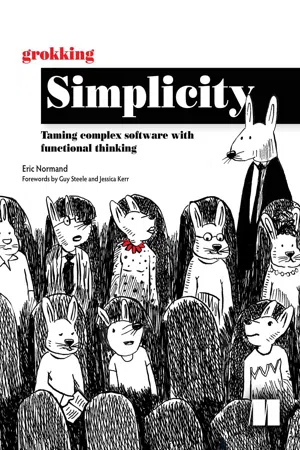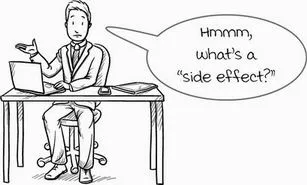
- 592 pages
- English
- ePUB (mobile friendly)
- Available on iOS & Android
About this book
"The most insightful and intuitive guide to clean and simple software. I recommend this to all software developers." - Rob Pacheco, Vision Government Solutions Grokking Simplicity is a friendly, practical guide that will change the way you approach software design and development. Distributed across servers, difficult to test, and resistant to modification—modern software is complex. Grokking Simplicity is a friendly, practical guide that will change the way you approach software design and development. It introduces a unique approach to functional programming that explains why certain features of software are prone to complexity, and teaches you the functional techniques you can use to simplify these systems so that they're easier to test and debug. Purchase of the print book includes a free eBook in PDF, Kindle, and ePub formats from Manning Publications. About the technology
Developers rightly fear the unintended complexity that infects most code. This book shows you how to write software that keeps complexity close to its inherent minimum. As you write software you should distinguish between code that alters your system's state, and code that does not. Once you learn to make that distinction, you can refactor much of your state-altering "actions" into stateless "calculations." Your software will be simpler. About the book
The book also teaches you to solve the complex timing bugs that inevitably creep into asynchronous and multithreaded code. In advanced sections of the book you learn how composable abstractions help avoid repeating code and open up new levels of expressivity. What's inside
Patterns for simpler code
Powerful time modeling approaches to simplify asynchronous code
How higher-order functions can make code reusable and composable About the reader
For intermediate and advanced developers building complex software. Exercises, illustrations, self-assessments, and hands-on examples lock in each new idea. About the author
Eric Normand is an expert software developer who has been an influential teacher of functional programming since 2007. Table of Contents
1 Welcome to Grokking Simplicity
2 Functional thinking in action
PART 1 - ACTIONS, CALCULATIONS, AND DATA
3 Distinguishing actions, calculations, and data
4 Extracting calculations from actions
5 Improving the design of actions
6 Staying immutable in a mutable language
7 Staying immutable with untrusted code
8 Stratified design, part 1
9 Stratified design, part 2
PART 2 - FIRST-CLASS ABSTRACTIONS
10 First-class functions, part 1
11 First-class functions, part 2
12 Functional iteration
13 Chaining functional tools
14 Functional tools for nested data
15 Isolating timelines
16 Sharing resources between timelines
17 Coordinating timelines
18 Reactive and onion architectures
19 The functional journey ahead
Frequently asked questions
- Essential is ideal for learners and professionals who enjoy exploring a wide range of subjects. Access the Essential Library with 800,000+ trusted titles and best-sellers across business, personal growth, and the humanities. Includes unlimited reading time and Standard Read Aloud voice.
- Complete: Perfect for advanced learners and researchers needing full, unrestricted access. Unlock 1.4M+ books across hundreds of subjects, including academic and specialized titles. The Complete Plan also includes advanced features like Premium Read Aloud and Research Assistant.
Please note we cannot support devices running on iOS 13 and Android 7 or earlier. Learn more about using the app.
Information
1 Welcome to Grokking Simplicity

- Learn the definition of functional thinking.
- Understand how this book is different from other books on functional programming.
- Discover the primary distinction that functional programmers make when they look at code.
- Decide whether this book is for you.
What is functional programming?

- a programming paradigm characterized by the use of mathematical functions and the avoidance of side effects** ** we need to define the underlined terms
- a programming style that uses only pure functions without side effects
- Sending an email
- Reading a file
- Blinking a light
- Making a web request
- Applying the brakes in a car
The problems with the definition for practical use
- a programming paradigm characterized by the use of mathematical functions and the avoidance of side effects
- a programming style that uses only pure functions without side effects
Problem 1: FP needs side effects
Problem 2: FP is good at side effects
Problem 3: FP is practical
The definition of FP confuses managers


- sending an email
- …


We treat functional programming as a set of skills and concepts

Distinguishing actions, calculations, and data
- Actions
- Calculations
- Data

Functional programmers distinguish code that matters when you call it
Table of contents
- Grokking Simplicity
- Copyright
- contents
- front matter
- 1 Welcome to Grokking Simplicity
- 2 Functional thinking in action
- Part 1. Actions, calculations, and data
- 3 Distinguishing actions, calculations, and data
- 4 Extracting calculations from actions
- 5 Improving the design of actions
- 6 Staying immutable in a mutable language
- 7 Staying immutable with untrusted code
- 8 Stratified design: Part 1
- 9 Stratified design: Part 2
- Part 2. First-class abstractions
- 10 First-class functions: Part 1
- 11 First-class functions: Part 2
- 12 Functional iteration
- 13 Chaining functional tools
- 14 Functional tools for nested data
- 15 Isolating timelines
- 16 Sharing resources between timelines
- 17 Coordinating timelines
- 18 Reactive and onion architectures
- 19 The functional journey ahead
- index
